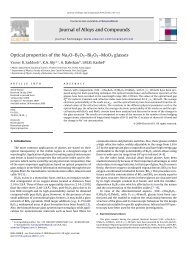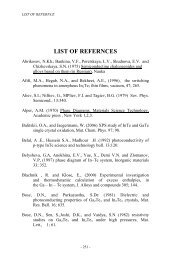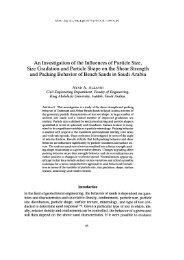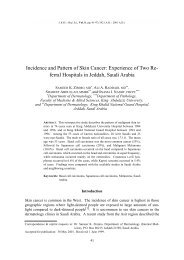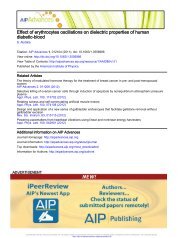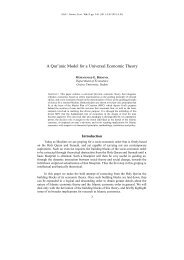Real-life SOA Experiences and an Approach Towards Semantic SOA
Real-life SOA Experiences and an Approach Towards Semantic SOA
Real-life SOA Experiences and an Approach Towards Semantic SOA
You also want an ePaper? Increase the reach of your titles
YUMPU automatically turns print PDFs into web optimized ePapers that Google loves.
define the control <strong><strong>an</strong>d</strong> data flow between the integrated applications <strong><strong>an</strong>d</strong> implement the business<br />
rules <strong><strong>an</strong>d</strong> business logic. Components in business logic layer interact with the preceding layer<br />
components by using some application adapter; data tr<strong>an</strong>sport protocols <strong><strong>an</strong>d</strong> or formats (fig. 3).<br />
As long as business applications development trend has ch<strong>an</strong>ged to business service<br />
development (extended with domain specific sem<strong>an</strong>tics) <strong><strong>an</strong>d</strong> the business logic layer comes in<br />
to focus, we begin to differentiate between architectural components that provide services <strong><strong>an</strong>d</strong><br />
those components that either orchestrate services (service composition on the basis of matching<br />
sem<strong>an</strong>tics <strong><strong>an</strong>d</strong> aggregation) or choreograph them (business rules <strong><strong>an</strong>d</strong> workflow). This difference<br />
between components that realize specific use-cases (services) <strong><strong>an</strong>d</strong> components that org<strong>an</strong>ize<br />
those use-cases into dynamic business rules (choreography <strong><strong>an</strong>d</strong> orchestration) is emphasized by<br />
splitting the business logic layer in two. These two layers jointly play the same role as business<br />
logic layer (i.e. event m<strong>an</strong>agement, process m<strong>an</strong>agement, data m<strong>an</strong>agement) <strong><strong>an</strong>d</strong> m<strong>an</strong>aging the<br />
control <strong><strong>an</strong>d</strong> data flow between services. When talking about integration architecture for SWS,<br />
we discuss the role of CO-Layer <strong><strong>an</strong>d</strong> services layer individually.<br />
The CO-Layer choreographs <strong><strong>an</strong>d</strong> orchestrates the services in the service layer with business<br />
rules <strong><strong>an</strong>d</strong> sem<strong>an</strong>tics. This is the agile layer of the 4-tier software architecture model. This layer<br />
is required to be dynamic - to meet the ch<strong>an</strong>ging requirements of the business enterprise. CO-<br />
Layer also needs to be adaptable as the enterprise grows through merger <strong><strong>an</strong>d</strong> acquisitions.<br />
Business logic <strong><strong>an</strong>d</strong> business rules c<strong>an</strong> be implemented here by separating them from the<br />
underlying infrastructure of the system’s operation. These rules c<strong>an</strong> be implemented in some<br />
structure l<strong>an</strong>guage. Even though CO-Layer <strong><strong>an</strong>d</strong> Services layer are emerged from business logic<br />
layer but components in these layers coordinate in such a way that these components are<br />
invoked precisely <strong><strong>an</strong>d</strong> in the right order by sending <strong><strong>an</strong>d</strong> receiving messages between CO-Layer<br />
<strong><strong>an</strong>d</strong> service layer components.<br />
The Services Layer is not new. For m<strong>an</strong>y it remains equivalent to the business logic layer <strong><strong>an</strong>d</strong><br />
contains a business rule service. The services layer is the realization of business processes in<br />
terms of discrete service definitions. This layer is inherently static as these services are tightly<br />
coupled to their implementations. However, when consistently defined in terms of IOPE with<br />
domain ontologies, services begin to reveal patterns of behaviour that c<strong>an</strong> be modelled <strong><strong>an</strong>d</strong><br />
orchestrated. As discussed above that the proposed integration architecture is a top down<br />
approach in which components in upper layer c<strong>an</strong> invoke components in lower layer therefore,<br />
business logic layer c<strong>an</strong> be interfaced with persistence layer by using some application adapters,<br />
protocols <strong><strong>an</strong>d</strong> data tr<strong>an</strong>sport formats to exch<strong>an</strong>ge messages. Splitting the business logic layer in<br />
to CO layer <strong><strong>an</strong>d</strong> service layer results in <strong>an</strong> additional interface to query for sem<strong>an</strong>tic Web<br />
services <strong><strong>an</strong>d</strong> getting its response.<br />
The reliability of the application integration architecture is intimately dependent on<br />
persistence components (Persistence Layer). In the whole integration architecture database<br />
systems are used to store <strong><strong>an</strong>d</strong> to m<strong>an</strong>age data. The data includes the messages, events, processes<br />
<strong><strong>an</strong>d</strong> configuration data. One possibility is to store all the information in some database but file<br />
systems c<strong>an</strong> also be used to store data in files as part of persistence layer. The newly emerged<br />
layer “service layer” in the integration architecture added <strong>an</strong> additional component to<br />
persistence layer (i.e. SWS registry). The CO-Layer <strong><strong>an</strong>d</strong> services layer <strong><strong>an</strong>d</strong> persistence layer coordinate<br />
by sending query for a required sem<strong>an</strong>tic Web service (sem<strong>an</strong>tic Web service request)<br />
<strong><strong>an</strong>d</strong> getting its response (sem<strong>an</strong>tic Web service response).<br />
The 4-tier sem<strong>an</strong>tic Web services integration architecture supports by integrating the<br />
sem<strong>an</strong>tically enriched Web services but it is not enough for dynamic, semi-automatic <strong><strong>an</strong>d</strong><br />
automatic <strong>an</strong>notation, advertisement, discovery, selection, composition <strong><strong>an</strong>d</strong> execution of interorg<strong>an</strong>ization<br />
business logic, making the Internet become a global common platform where




